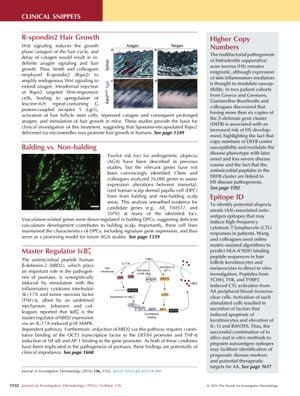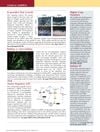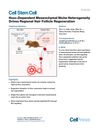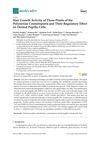Clinical Snippets: Hair Growth, Androgenetic Alopecia, Psoriasis, Hidradenitis Suppurativa, and Alopecia Areata
July 2016
in “
Journal of Investigative Dermatology
”
R-spondin2 Wnt signaling anagen phase hair cycle hair growth liposome-encapsulated Rspo2 microneedles gene expression vasculature-related genes androgenetic alopecia antimicrobial peptide human B-defensin-2 IKB IL-17A B-defensin gene cluster DEFB hidradenitis suppurativa acne inversa cytotoxic T lymphocyte CTL epitopes alopecia areata Rspo2 Wnt AGA hBD2 HS AA

TLDR R-spondin2 may help treat hair loss, gene differences could explain baldness, a peptide's regulation is linked to psoriasis, B-defensin gene copies may affect a skin condition's risk and severity, and potential markers and targets for alopecia areata were identified.
In a study by Smith and colleagues, R-spondin2 (Rspo2) was used to amplify endogenous Wnt signaling, which extended the anagen phase of the hair cycle and stimulated hair growth in mice. This suggests potential for clinical treatment of hair loss in humans using liposome-encapsulated Rspo2 delivered via microneedles. Chew and colleagues identified differences in gene expression between balding and non-balding scalp areas, finding down-regulation of vasculature-related genes in balding areas, which may contribute to androgenetic alopecia (AGA). These findings could help in developing models for future AGA studies. Johansen and colleagues discovered that the antimicrobial peptide human B-defensin-2 (hBD2) is regulated by IKB via an IL-17A-induced pathway, which is relevant to the pathogenesis of psoriasis. Giamarellos-Bourboulis and colleagues found that higher copy numbers of the B-defensin gene cluster (DEFB) increase the risk of hidradenitis suppurativa/acne inversa (HS), suggesting that DEFB copy numbers affect HS susceptibility and disease severity. Lastly, Wang and colleagues used in silico and in vitro methods to identify cytotoxic T lymphocyte (CTL) activating epitopes in alopecia areata (AA), which could lead to prognostic disease markers and therapeutic targets for AA.



